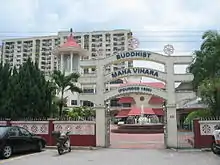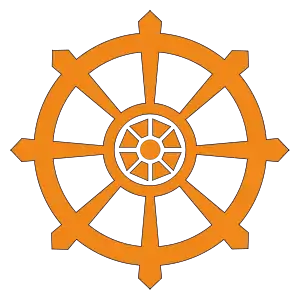| Buddhist Maha Vihara | |
|---|---|
 Front view of the temple gate | |
| Religion | |
| Affiliation | Buddhism |
| Governing body | Malaysian Buddhist Consultative Council |
| Patron | Ven Datuk Kirinde Sri Dhammaratana, Buddhist Chief High Priest of Malaysia |
| Status | Active |
| Location | |
| Location | Brickfields, Kuala Lumpur |
| State | Kuala Lumpur |
| Country | Malaysia |
| Administration | Sasana Abhiwurdhi Wardhana Society |
| Geographic coordinates | 3°7′40.395″N 101°41′12.527″E / 3.12788750°N 101.68681306°E |
| Architecture | |
| Type | Sri Lankan temple |
| Founder | Patthalagedera Dhammananda Thera[1] |
| Date established | 1895 |
| Website | |
| www | |
Buddhist Maha Vihara (Sinhala: මහින්ද්රා බෞද්ධ පන්සල) (also called as the Brickfields Buddhist Temple)[2] is a Sri Lankan temple situated in Brickfields of Kuala Lumpur in Malaysia. The temple became a focal point for the annual Wesak festival within the city suburb.[3][4][5]
History
After the establishment of the first Sinhalese temple called Bodhi Langka Ram Vihar in Perak of British Malaya in 1889, a second temple was proposed by the Sinhalese community in 1894 to be construct in an area within the administration capital of Kuala Lumpur where large numbers of their community civil servants are living and working.[1][2][6][7] Facing financial difficulties to acquire a land, the community then appeal to the British government through English engineer C.E. Spooner.[1] The British government responded to the request but said any land in the administration capital intended for public service can only be granted towards an organisation.[1] After a thorough discussion among the Sinhalese community, they agreed to form an organisation called the Sāsana Abhiwurdhi Wardhana Society which also responsible to resolve social issues among their community with a foundation stone for the temple shrine room being laid down on 25 August 1894.[1][6]
Through the inaugural meeting among the community, they agreed that the appointment of the temple abbot should be from British Ceylon and the temple administration would be under the Sinhalese.[6] A living quarters was then built to house the first monk Patthalagedera Dhammananda Thera and his student Godagama Sobhita Thera from British Ceylon who later arrived in 1895 which also marked the foundation of the temple in the same year; despite the structure was only completed in the first decade of the 20th century,[1][8] as the control from one primary race became a constraint on the temple development until the policy was rebuked in the later years.[6] Although the temple management is solely controlled by the Sinhalese, a donor list published by the temple management showed that local Chinese Buddhist also donated a huge sum of money during the temple construction;[9] the largest sum of donation coming from Chinese Kapitan of Kuala Lumpur, Yeap Quang Seng.[6] Since 1920, Chinese devotees also became increasingly significant in the temple.[6]
Features
Since the foundation of the organisation, the Sāsana Abhiwurdhi Wardhana Society is responsible for the administration of the temple and all activities conducted on site.[6] Religious activities are annually organised by the society. With the establishment of the modern country of the Federation of Malaysia, the society was registered on 3 April 1962.[10] Following the amendments of the country constitution in 1996, the society name was changed to the Buddhist Missionary Society Malaysia with the temple become its headquarters.[10][11]
 Decorations at the temple during Wesak in 2006.
Decorations at the temple during Wesak in 2006. Lotus flower decoration at the temple during Wesak in 2007.
Lotus flower decoration at the temple during Wesak in 2007.
References
- 1 2 3 4 5 6 Rajesh Rai; Chitra Sankaran (5 July 2017). Religion and Identity in the South Asian Diaspora. Taylor & Francis. p. 128. ISBN 978-1-351-55159-5.
- 1 2 "Buddhist Maha Vihara". VisitKL. Archived from the original on 1 April 2019. Retrieved 1 April 2019.
- ↑ Christina Low (19 May 2014). "An illuminated procession during Wesak celebrations". The Star. Retrieved 1 April 2019.
- ↑ Dawn Chan (3 May 2015). "Wesak Day festivities start in Brickfields". New Straits Times. Retrieved 1 April 2019.
- ↑ Kathleen Michael (28 May 2018). "Special arch for Wesak Day". The Star. Retrieved 1 April 2019.
- 1 2 3 4 5 6 7 Tan Lee Ooi (2018). "Buddhist Maha Vihara during Colonial Times [Chapter 1 – Introduction]" (PDF). Asian Studies Centre, Thailand. p. 34/278. Retrieved 1 April 2019.
The Sasana Abhiwurdhi Wardhana Society established the Buddhist Maha Vihara temple in 1894 at Brickfields in Kuala Lumpur. Addiction to alcohol became a serious social problem for Sinhalese community in the early 20th century. Many Sinhalese became poor and "lost their land property to Chettiars". The aims of the society were to seek "a proper place of worship for the Sinhala Buddhists in accordance with their Theravāda tradition as well as for a burial ground for the community". According to the inaugural meeting minutes of the temple, the appointment of the temple abbot should be from Ceylon and administration of the temple should be Sinhalese. This principal of maintaining the control of the Sinhalese became a constraint on the development of the temple until it was rebuked in the later years. Even though the Sinhalese legitimately controlled the management of the temple, the involvement of Chinese Buddhists in temple affairs had been ongoing. The list of donors in 1896 who contributed the building fund showed that Chinese donated a huge sum of money. The largest sum of donation was from Yeap Quang Seng, who was the Chinese Capitan in Kuala Lumpur. In 1928, a resident monk observed that "on their arrival in Kuala Lumpur a vast crowd of Sinhala and Chinese Buddhists accorded them with a warm welcome". Chinese devotees became increasingly significant after 1920.
- ↑ "Buddhist Maha Vihara Brickfields - Kuala Lumpur". Tourism Malaysia. Retrieved 1 April 2019.
- ↑ Thomas Borchert (17 April 2018). Theravada Buddhism in Colonial Contexts. Taylor & Francis. p. 127. ISBN 978-1-351-62036-9.
- ↑ "Profile of Buddhist Maha Vihara, Brickfields". Buddhist Maha Vihara, Brickfields. Archived from the original on 1 April 2019. Retrieved 1 April 2019.
- 1 2 J. Gordon Melton; Martin Baumann (21 September 2010). Religions of the World: A Comprehensive Encyclopedia of Beliefs and Practices, 2nd Edition [6 volumes]. ABC-CLIO. p. 441. ISBN 978-1-59884-204-3.
- ↑ "Buddhist Missionary Society Malaysia and Buddhist Maha Vihara - Malaysia". Buddha Channel TV. 15 February 2010. Archived from the original on 1 April 2019. Retrieved 1 April 2019.
News articles
- "Devotees, tourists observe Wesak Day at 125-year-old Buddhist temple". New Straits Times (online). 19 May 2019. Retrieved 19 July 2022.
External links
 Media related to Buddhist Maha Vihara, Brickfields at Wikimedia Commons
Media related to Buddhist Maha Vihara, Brickfields at Wikimedia Commons- Official website

